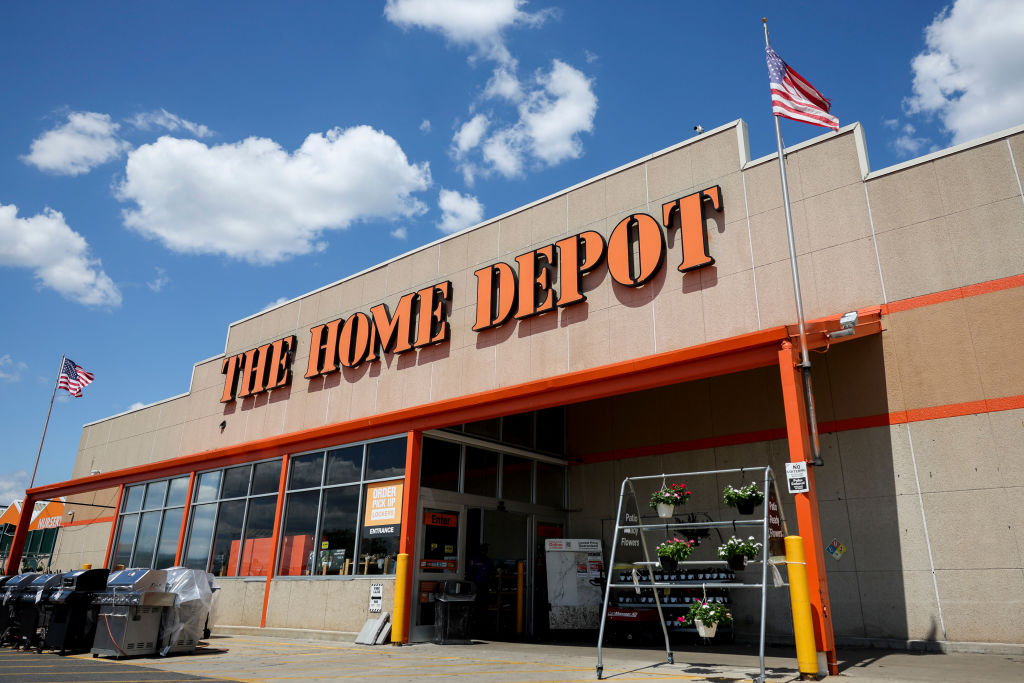The Best Retail Stocks to Buy and Hold
E-commerce is a growing trend, but most folks still prefer to shop in stores. That makes these dominant retail stocks worth a closer look.


Americans love shopping, which is good news for investors seeking out the best retail stocks to buy.
Although Amazon.com (AMZN) and other online retailers seem to have taken over in today's digital-first world, about 80% of U.S. retail sales still happen within the confines of brick-and-mortar stores, according to recent data from Statista.
In another study, nearly half of consumers surveyed said they prefer shopping in-store because it offers a more enjoyable experience. And about half of those who would rather shop in a store do so because it allows them to see and try products firsthand.

Sign up for Kiplinger’s Free E-Newsletters
Profit and prosper with the best of expert advice on investing, taxes, retirement, personal finance and more - straight to your e-mail.
Profit and prosper with the best of expert advice - straight to your e-mail.
This is why large retailers with multiple store locations, such as Walmart (WMT), Home Depot (HD), and even an outlier like Sherwin-Williams (SHW) – which was recently added to the Dow Jones Industrial Average – can deliver such superb returns to their shareholders.
Retailing is a tricky business and getting the right formula takes time and money. Many retailers have fallen by the wayside (see Sears, Blockbuster and Toys "R" Us). Still, others have prospered. Here, we look at three of of the best retail stocks for investors to buy and hold.
Walmart

- Market value: $762.9 billion
- Dividend yield: 1.0%
Over the decades, Walmart (WMT) transformed from a local discount store in Arkansas into the world's largest retailer, a growth story built on consistent financial discipline, strategic expansion and a commitment to low prices.
Walmart's success as one of the best retail stocks is due to its ability to expand its store network while improving margins, even in the face of economic challenges such as inflation and supply chain disruptions.
Walmart's "Every Day Low Prices" strategy is central to its success, making it a go-to for price-sensitive consumers. This commitment to low prices has been possible due to Walmart's relentless focus on efficiency and cost control, as reflected in its stable gross margins over time. Looking at the past 10 years, Walmart has kept its gross margin in the range of 24% to 26%.
The company's ability to sustain this margin demonstrates operational efficiency and bargaining power with its suppliers, key drivers behind its capacity to absorb cost increases and maintain competitive pricing during periods of high inflation.
To illustrate, when the inflation rate in the U.S. – as measured by the Consumer Price Index (CPI) – peaked at 9.1% in 2022, Walmart kept its gross margin at 24.1%, just one percentage point lower than the previous year's gross margin of 25.1%. And when inflation slowed down in 2023, Walmart's gross margin recovered back to 26.2%.
By enhancing supply chain efficiency and reducing inventory costs, WMT can protect and even expand its margins, all while keeping prices low for consumers. Further, the company is investing heavily in automation, such as self-checkout systems, and adopting robotics in its distribution centers, significantly reducing labor costs and enhancing throughput.
In July 2024, Reuters reported that Walmart was in talks with Fox Robotics to potentially invest $200 million in autonomous forklifts. The company has also partnered with Digimarc, a global leader in product digitization, to test new barcode technology that will prevent theft at its self-checkout machines.
While Walmart's financial discipline plays a major role in its growth, so does its strategic expansion. The company's network grew rapidly from 3,662 stores in 2000 to more than 10,000 stores by 2012 and over 11,000 locations globally by 2024. This consistent expansion has enabled WMT to reach a diverse customer base across the United States and around the world.
Evaluating sales per store offers insight into how effectively Walmart's stores perform, particularly as it opens new locations. In 2000, Walmart's revenue was approximately $167 billion, yielding an average of $45.6 million per store. In 2023, sales had increased to over $611 billion. With over 10,600 stores, the sales per store rose to approximately $57.5 million, signaling an uptick in productivity per location. This improvement suggests that WMT's strategy isn't solely about opening more stores but also growing the potential of each location.
Walmart's financial performance over the years underscores a resilient business model that can withstand economic pressures and maintain steady growth. Its approach to keeping prices low, improving gross and operating margins, and strategically expanding its store network has allowed it to thrive during periods of economic uncertainty, including inflationary pressures.
While many retailers struggle to balance growth with margin preservation, Walmart has consistently demonstrated its ability to do both, signaling the blue chip stock's strong long-term potential for investors.
Home Depot

- Market value: $379.2 billion
- Dividend yield: 2.4%
Home Depot (HD) is not a monopoly, but the company has accrued monopoly power by building an unassailable moat as the largest home improvement retailer. HD's footprint is massive, with roughly 2,350 stores across North America as of Q4 2024. The company's expansion strategy was not to simply build as many stores as it could. Rather, its expansion strategy was to fill out locations in all the primary, secondary and tertiary markets. This is evidenced by the fact that after decades of rapid expansion, Home Depot's store count has remained fairly constant since 2008.
This has more or less kept competitors at bay. For a competitor to match HD's market saturation, it would need to finance the development of around 2,000 stores while contending with strong competition from both Home Depot and Lowe's (LOW), which operates 1,750 stores.
Further, Home Depot has dramatically increased sales per location. In 2005, with 1,890 stores and $73 billion in revenue, each store averaged about $39 million in sales. By the end of 2024, with 2,347 stores and $159.5 billion in revenue, the average sales per store rose to $68 million – a significant increase of 74%.
Home Depot has shifted its priority from physical store growth to investing significantly in its digital platforms, aligning with shifts in consumer behavior. Digital sales now account for nearly 15% of net sales and the company's seamless integration of online and in-store shopping options has allowed it to capture a wider audience.
One of the retailer's most remarkable accomplishments over the years has been its ability to maintain its gross and operating margins despite fluctuations in the economic landscape. The company's gross margin has consistently stayed around 34% over the past 10 years. Its operating margin has also been steady, hovering in a range of 14% to 17%, which showcases HD's efficiency in managing costs.
Home Depot's commitment to shareholder value has also been consistent, marked by reliable dividend payments and stock buybacks. Over the past decade, Home Depot has been one of the best dividend growth stocks, having quadrupled its annual payout, with yields often exceeding 2%. It has also maintained a payout ratio of around 50%, providing a balance between reinvestment and shareholder returns.
This dividend growth is supported by strong cash flow, which allows Home Depot to reinvest in growth while rewarding shareholders.
Home Depot's capital return program has also included substantial share repurchases. The company has reduced its share count from 1.3 billion shares in 2014 to 993 million as of December 2024. This has contributed to higher earnings per share (EPS) and reinforced shareholder value.
For investors, HD's performance and consistent dividends signal a mature, growth-oriented company with a track record of delivering value – and the foundation to continue doing so in a dynamic retail landscape. That's why it's on this list of the best retail stocks to buy.
Sherwin-Williams

- Market value: $89.3 billion
- Dividend yield: 0.9%
Sherwin-Williams (SHW) is technically a materials stock – and not typically what comes to mind for most folks when thinking of dominant retailers. But the paint maker operates more than 5,000 stores, a number that's higher than Home Depot, Target (TGT) or PetSmart.
SHW's earnings growth has been fueled by these stores, but also through acquisitions. Since 2007, Sherwin Williams has acquired 10 companies and, in the process, assembled some of the best-known brands in the U.S. and in select overseas markets.
A recent example is Valspar which the company acquired in 2017, one of the largest in Sherwin-Williams' history. This purchase enabled SHW to gain a stronger foothold in the international market, doubling its distribution capacity in regions like Asia and Europe and positioning it as a global leader.
Mergers and acquisitions are tricky and can lead to losses if the acquired companies fail to perform. Ask AOL, which acquired Time Warner. Or Hewlett-Packard, which acquired Compaq. Or Sprint, which acquired Nextel. All disasters.
But Sherwin-Williams has not reported a loss in at least 20 years. Instead, the company has grown revenue at approximately 7% annually since 2004 and earnings per share at nearly 13%. How did it do that?
First, Sherwin-Williams continues to squeeze costs. While the spread between what it takes to manufacture paint and its selling price, or the gross margin, has been fairly constant over the decades, SHW has been able to squeeze operating costs a little more each year and, in the process has raised their operating margin by nearly 60%.
Second, the company also consistently buys back its shares. In 2004, SHW had 422 million shares outstanding. At the end of 2024, the share count was 250 million, a 40% reduction. The net effect of this decline is a constant upward movement in the earnings per share and an upward bias in the stock price.
Another source of value for shareholders is the retail stock's dividends. Sherwin-Williams has increased its dividend payout consistently over the past four decades, a testament to its strong cash flow and commitment to shareholder returns. In 2010, the annual dividend payout was around 27.3 cents per share, and in 2025, it will be %2.86 per share. The dividend yield for Sherwin-Williams is modest, currently less than 1%. But it's a grower.
Growing a dividend for more than four decades is a pretty good trick, but in the case of Sherwin-Williams, the dividend can be considered safe too. SHW's dividend payout ratio is approximately 25%, which is generally be considered to be low for dividend-paying companies. Remember, the dividend payout ratio is the percent of total earnings that the company pays to shareholders in the form of dividends.
Related content
Get Kiplinger Today newsletter — free
Profit and prosper with the best of Kiplinger's advice on investing, taxes, retirement, personal finance and much more. Delivered daily. Enter your email in the box and click Sign Me Up.

-
 5 Historic Philadelphia Homes for Sale Now
5 Historic Philadelphia Homes for Sale NowPhiladelphia is a goldmine of historic properties that rival the best in New York, London and Paris for charm and opulence. Here are five gems you can own.
By Charlotte Gorbold
-
 When to Sell Your Stock
When to Sell Your StockKnowing when to sell a stock is a major decision investors must make. While there's no one correct answer, we look at some best practices here.
By Charles Lewis Sizemore, CFA
-
 When to Sell Your Stock
When to Sell Your StockKnowing when to sell a stock is a major decision investors must make. While there's no one correct answer, we look at some best practices here.
By Charles Lewis Sizemore, CFA
-
 Within Five Years of Retirement? Five Things to Do Now
Within Five Years of Retirement? Five Things to Do NowIf you're retiring in the next five years, your to-do list should contain some financial planning and, according to current retirees, a few life goals, too.
By Evan T. Beach, CFP®, AWMA®
-
 The Home Stretch: Seven Essential Steps for Pre-Retirees
The Home Stretch: Seven Essential Steps for Pre-RetireesThe decade before retirement is the home stretch in the race to quit work — but there are crucial financial decisions to make before you reach the finish line.
By Mike Dullaghan, AIF®
-
 Stock Market Today: Great Power Affairs Mesmerize Markets
Stock Market Today: Great Power Affairs Mesmerize MarketsThe U.S. and China are at least talking about talking about tariffs, and investors, traders and speculators are showing a little less fear.
By David Dittman
-
 Three Options for Retirees With Concentrated Stock Positions
Three Options for Retirees With Concentrated Stock PositionsIf a significant chunk of your portfolio is tied up in a single stock, you'll need to make sure it won't disrupt your retirement and legacy goals. Here's how.
By Evan T. Beach, CFP®, AWMA®
-
 Four Reasons It May Be Time to Shop for New Insurance
Four Reasons It May Be Time to Shop for New InsuranceYou may be unhappy with your insurance for any number of reasons, so once you've decided to shop, what is appropriate (or inappropriate) timing?
By Karl Susman, CPCU, LUTCF, CIC, CSFP, CFS, CPIA, AAI-M, PLCS
-
 Stock Market Today: Stocks Rise on Good Volatility
Stock Market Today: Stocks Rise on Good VolatilityInvestors, traders and speculators continue to process the "known unknown" of global tariff-and-trade war negotiations.
By David Dittman
-
 Before You Invest Like a Politician, Consider This Dilemma
Before You Invest Like a Politician, Consider This DilemmaAs apps that track congressional stock trading become more popular, investors need to take into consideration some caveats.
By Ryan K. Snover, Investment Adviser Representative